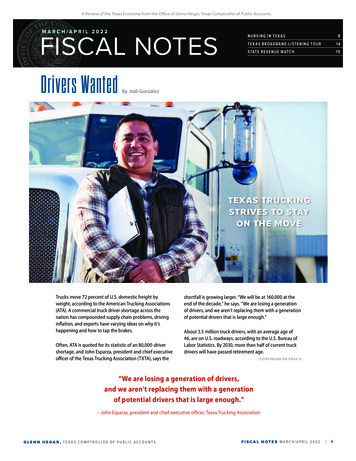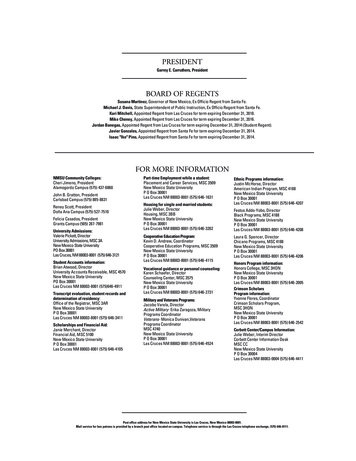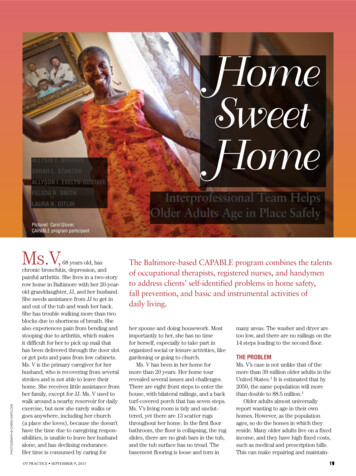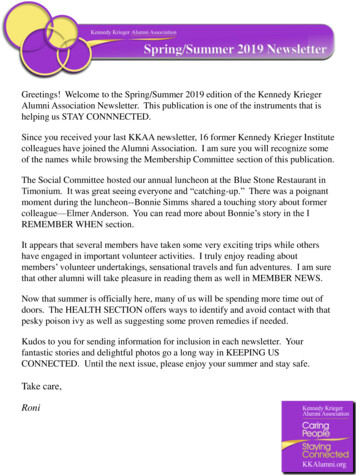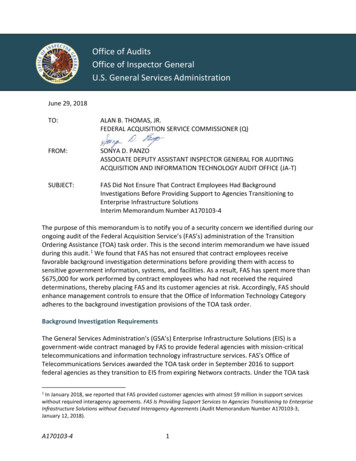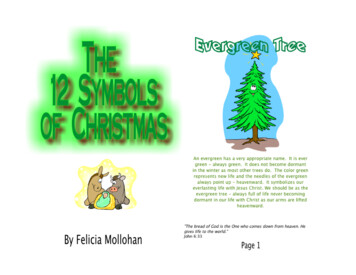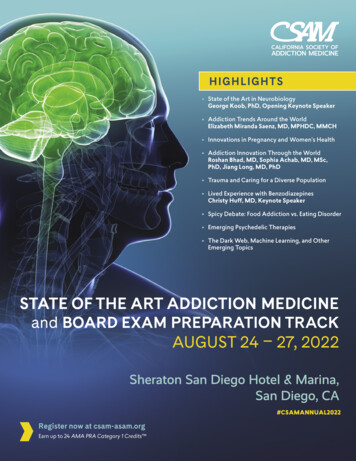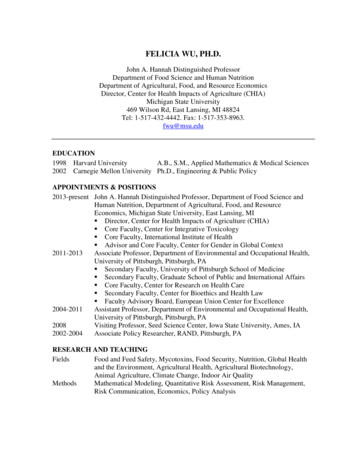
Transcription
FELICIA WU, PH.D.John A. Hannah Distinguished ProfessorDepartment of Food Science and Human NutritionDepartment of Agricultural, Food, and Resource EconomicsDirector, Center for Health Impacts of Agriculture (CHIA)Michigan State University469 Wilson Rd, East Lansing, MI 48824Tel: 1-517-432-4442. Fax: 1-517-353-8963.fwu@msu.eduEDUCATION1998 Harvard UniversityA.B., S.M., Applied Mathematics & Medical Sciences2002 Carnegie Mellon University Ph.D., Engineering & Public PolicyAPPOINTMENTS & POSITIONS2013-present John A. Hannah Distinguished Professor, Department of Food Science andHuman Nutrition, Department of Agricultural, Food, and ResourceEconomics, Michigan State University, East Lansing, MI Director, Center for Health Impacts of Agriculture (CHIA) Core Faculty, Center for Integrative Toxicology Core Faculty, International Institute of Health Advisor and Core Faculty, Center for Gender in Global Context2011-2013Associate Professor, Department of Environmental and Occupational Health,University of Pittsburgh, Pittsburgh, PA Secondary Faculty, University of Pittsburgh School of Medicine Secondary Faculty, Graduate School of Public and International Affairs Core Faculty, Center for Research on Health Care Secondary Faculty, Center for Bioethics and Health Law Faculty Advisory Board, European Union Center for Excellence2004-2011Assistant Professor, Department of Environmental and Occupational Health,University of Pittsburgh, Pittsburgh, PA2008Visiting Professor, Seed Science Center, Iowa State University, Ames, IA2002-2004Associate Policy Researcher, RAND, Pittsburgh, PARESEARCH AND TEACHINGFieldsFood and Feed Safety, Mycotoxins, Food Security, Nutrition, Global Healthand the Environment, Agricultural Health, Agricultural Biotechnology,Animal Agriculture, Climate Change, Indoor Air QualityMethodsMathematical Modeling, Quantitative Risk Assessment, Risk Management,Risk Communication, Economics, Policy Analysis
AWARDS & HONORS Investiture Awardee, Michigan State University, 2016 American Public Land-Grant Universities (APLU) Challenge for Change SelectedMember, Global Food Security, 2016 United States National Academy of Sciences: National Research Council (NRC)Committee on Considerations for the Future of Animal Science Research, 2014-2015 International Life Sciences Institute (ILSI) Food, Nutrition, & Safety Program ScientificAdvisor, 2014-2017 World Health Organization (WHO) Foodborne Disease Burden Epidemiology ReferenceGroup (FERG) Member, Computational Task Force, 2012-current Joint Expert Committee on Food Additives (JECFA) of the Food and AgricultureOrganization (FAO) and World Health Organization (WHO) of the United Nations,Expert Roster, 2011-current SCOPE-Zhongyu Young Scientist Award on Environmental Issues (1 of 3), 2011 National Institutes of Health (NIH) EUREKA Award, 2010-2014 WHO FERG Resource Advisor, Chemicals & Toxins Task Force, 2010-current Society for Risk Analysis Councilor, 2009-2012 James L. Craig Excellence in Education Teaching Award Nominee, University ofPittsburgh Graduate School of Public Health, 2009, 2011 Sigma Xi (National Science Honor Society) Distinguished Lecturer, 2008-2009 Visiting Professor, Iowa State University, 2008 University of Pittsburgh Outstanding Women in Medicine & Science (1 of 7), 2008 Chauncey Starr Award, Society for Risk Analysis: Outstanding risk analyst age 40 orunder, 2007 NIH Early Career Award: Multidisciplinary Clinical Research Scholars Program, 20072011 Guest Editor, Environmental Health Perspectives: “Developing Policies to ImproveIndoor Environmental Quality,” June 2007 U.S. Department of Agriculture, Aflatoxin Elimination grantee, 2007-2008, 2006-2007 Competitive Medical Research Fund, University of Pittsburgh, 2006-07 Delta Omega National Honor Society for Public Health, Inducted Faculty Member, 2006 Chair of Conference: Developing Policies to Improve Indoor Environmental Quality:Trans-Atlantic Viewpoints, 2005 Society for Risk Analysis Best Paper Award, 2002, 2003 EPA STAR (Science To Achieve Results) Fellowship, 1999-2002 ExxonMobil Paper Award in Risk Communication, 2000, 2001 IIASA (International Institute for Applied Systems Analysis) Young Scientists SummerProgram, 2000 Harvard College Scholar (Dean's List), 1995-98 Elizabeth Cary Agassiz Merit Award for Academic Excellence, 1995-98 Jeopardy! Teen Tournament Semi-finalist, 1994GRANTS FUNDED AS FACULTY MEMBER (CURRENT AND PAST)2013-2018Co-Project Director: United States Department of Agriculture (USDA)Agriculture & Food Research Initiative (AFRI), “Integrated
006-2007Management Strategies for Aspergillus and Fusarium Ear Rots ofCorn” ( 5,349,650)Principal Investigator: Insect Knowledge Management Program(Monsanto), “An Agent-Based Model of Insect Adaptation toTransgenic Insecticidal Corn” ( 299,978)Co-Project Director: USDA AFRI, “Risk Assessment and InterventionStrategies for the Emerging Food Safety Threat of Ochratoxin in theUnited States” ( 1,500,000)Principal Investigator: Bill & Melinda Gates Foundation, “Mycotoxinsas a Risk Factor in Growth Impairment Worldwide” ( 750,000)Principal Investigator: National Institutes of Health (NIH) NationalCancer Institute, “The Effect of Aflatoxin Regulation on Global LiverCancer Risk” (R01: 1,480,096)Co-Project Director: USDA AFRI, “Prediction and Mitigation ofFoodborne Disease Potential of Emerging Trichothecene Mycotoxins”( 500,000)Co-Project Director: USDA Biotechnology Risk Assessment Grant(BRAG), “Mycotoxin Risks Associated with Ethanol Co-Productsfrom Conventional vs. Biotechnology-Derived Corn Grain”( 400,000)Co- Principal Investigator: Bill and Melinda Gates Foundation, “CostEffective Aflatoxin Risk Reduction Strategies in Maize and GroundnutValue Chains to Improve Market Access of the Poor in Africa”( 2,700,000)NIH Early Career Awardee: National Institutes of Health (NIH)Multidisciplinary Clinical Research Scholars Program, “GlobalBurden of Mycotoxin-Induced Disease and Cost-Effectiveness ofInterventions” (KL2: 669,000)Principal Investigator: Computational Public Health Initiative,University of Pittsburgh, “Modeling the Effect of AflatoxinRegulations on Global Liver Cancer Risk and World Food Trade”( 20,000)Principal Investigator: USDA Aflatoxin Elimination Workgroup,“Modeling the Adverse Impact of Aflatoxin Contamination to theEconomics of U.S. Agriculture” ( 27,000)Principal Investigator: USDA Aflatoxin Elimination Workgroup,“Total Economic Impact of Aflatoxin: Models of Economic Loss andIndustry Learning” ( 10,000)Principal Investigator: Competitive Medical Research Fund,“Achieving Healthy Homes for Asthmatic Children ThroughEducational Interventions” ( 25,000)GRANTS PENDING & SUBMITTED, LAST 12 MONTHS CoPI: Alliance for African Partnership, Michigan State University, “ExpandingMSU’s Global Push-Pull Knowledge Systems through Deep Partnerships withCross-Country Academic Institutions in Ethiopia and Kenya” ( 200,000)
PI: MacArthur Foundation 100&Change, “The Fusion Revolution”( 100,000,000)PI: USDA NIFA, “Integrated Assessment Of Health And Economic Impacts OfNontraditional Water Use In Crop Agriculture” ( 500,000)Co-PI: Bill & Melinda Gates Foundation, “Development of innovative imaging orother technologies to measure individuals’ dietary intakes” ( 1,476,000) (notfunded)PI: NSF INFEWS, “FEW Systems Modeling to Optimize Food Production andEnergy Sustainability through Water Resource Recovery” ( 2,999,904) (notfunded)SCIENTIFIC ALLIANCES2009-2013MycoRed: Novel Integrated Strategies for Worldwide MycotoxinReduction in Food and Feed Chains. European CommissionCONTRACTS2012-13World Health Organization (WHO) Foodborne Disease BurdenEpidemiology Reference Group (FERG): Estimating global burden ofhuman disease caused by foodborne arsenic2010WHO FERG: Estimating global burden of human disease caused byfoodborne aflatoxinINVITED LECTURES AND SESSION CHAIRSDairy Council Practices Annual Conference (Antibiotic Resistance), 2016Center for Research on Ingredient Safety Conference, East Lansing, MI 2016International Food Safety Workshop, Michigan State University, 2016World Mycotoxin Forum and International Union on Pure & Applied Chemistry(WMF meets IUPAC), Winnipeg, Canada, 2016Workshop on the Field and Science of Risk Analysis, Ann Arbor, MI, 2016Fate of the Earth (Plenary Speaker), Michigan State University, 2016USAID AgriLinks Webinar “Breaking the Mold” (Featured Speaker), 2015International Life Sciences Institute (ILSI) Food, Nutrition, & Safety Program AnnualMeeting, Washington, DC, 2015W.K. Kellogg Biological Station Research Seminar, Michigan State University, 2015USAID Bureau for Food Security: Agricultural Policy for Maternal and Child HealthRoundtable, 2014Plant Biotechnology for Health and Sustainability 3rd Annual Symposium, MichiganState University, 2014Center for Integrative Toxicology, Michigan State University, 2014ILSI Role and Use of Nutritional Studies in Evaluating the Safety of a Food orIngredient, 2014International Agency for Research on Cancer (IARC) (Plenary Lecture), AflatoxinControl Measures: A Basis for Improved Health in Developing Countries, 2014
American Association of Cereal Chemists International (AACCI) Annual Meeting,Providence, RI, 2014USDA Foreign Agricultural Service: International Agricultural Biotechnology Grouppanelist, Michigan State University, 2014Biotechnology Regulation Immersion Course, University of Missouri, 2014Global Risk Forum One Health Summit (Keynote Lecture), Davos, Switzerland, 2013Toxicology Forum-Risk Governance Initiative (Keynote Lecture), Ottawa, Canada,2013Aflatoxin Symposium, Center in Molecular Toxicology, Vanderbilt University, 2013Summer Academy in Global Food Law & Policy, Granada, Spain, 2013MycoRed Europe Conference, Martina Franca, Italy, 2013International Aflatoxin-in-Maize Working Group: Global Solutions for WorldwideProblems (Keynote Lecture), USAID/USDA, New Orleans, LA, 2013Mycotoxins: Triple Threat to African Development, Washington, DC, 2013The Role of Academic Medical Centers in Addressing Health Disparities Conference(Spotlight Lecture), Pittsburgh, 2012World Nutrition Forum (Keynote Lecture), Singapore, 2012MycoRed North America Conference (Keynote Lecture), Ottawa, Canada, 2012Impact of Mycotoxins on Gut Function & Stunting, Bill & Melinda Gates Foundation, 2012Conference on Food Security, Purdue University, 2012International Workshop on Socio-Economic Impacts of Genetically Modified Crops, Seville,Spain, 2011Nutrition Seminar Series, Johns Hopkins Bloomberg School of Public Health, 2011Infectious Diseases Series, University of Pittsburgh Graduate School of Public Health, 2011MycoRed Africa Conference, Cape Town, South Africa, 2011Society of Toxicology, 2011World Health Organization (WHO) Foodborne Disease Burden Epidemiology ReferenceGroup and Stakeholders Meeting, Geneva, Switzerland, 2010Michigan State University, Distinguished Scholars in Toxicology Lecture Series, 2010World Nutrition Forum (Keynote Lecture), Salzburg, Austria, 2010World Health Organization (WHO) Foodborne Disease Burden Epidemiology ReferenceGroup, Tunis, Tunisia, 2010Science 2010, University of Pittsburgh, 2010Global Health Research Development Seminar, University of Pittsburgh, 2010Gordon Research Conference on Mycotoxins and Phycotoxins, 2009, 2007, 2005, 2003International Agency for Research on Cancer (IARC), Lyon, France, 2009Kenya Stakeholders’ Inception Workshop on Aflatoxin Reduction, Nairobi, Kenya, 2009International Society for Mycotoxicology, Vienna, Austria, 2009Brookings Institution, 2009Food for Thought Distinguished Lecture Series, Oregon State University, 2009Sigma Xi Distinguished Lecture – Environmental and Health Impacts of Transgenic Crops,Indiana University of Pennsylvania, 2009Sigma Xi Distinguished Lecture: Aflatoxin - Reducing Health Risks Through Public HealthInterventions, US Department of Agriculture (USDA), 2009Sigma Xi Distinguished Lecture: Ethanol and the Environment, Iowa State University, 2008Sigma Xi Distinguished Lecture: Ethanol and the Environment, University of Nebraska 2008
World Mycotoxin Forum (Plenary Lecture), 2008, 2006, 2005United Nations Convention on Biological Diversity 4th Meeting of the Parties (MOP4), 2008Senior Vice Chancellor’s Research Seminar, University of Pittsburgh, 2008National Fusarium Head Blight Forum (Plenary Lecture), 2007USDA Aflatoxin Elimination Workshop, 2007, 2006Monsanto Company, 2007Pioneer Hi-Bred International, Inc., 2007Department of Energy, Energy Codes 2007US/EU Trans-Atlantic Conference: REACH, 2007USDA / North American Millers Association, Corn Dry Milling Conference, 2007USDA APHIS Biotechnology Regulatory Services Seminar, 2007Biosafety Institute for Genetically Modified Agricultural Products (BIGMAP) Symposium,Iowa State University, 2007Engineering Sustainability: Mascaro Sustainability Initiative, University of Pittsburgh, 2007Canadian Institute of Food Science & Technology Conference (Plenary Lecture), 2006Audubon Society, GMO Food Safety & the Environment, 2006University of Pittsburgh Board of Trustees Meeting, 2006Dutch Ministry of Housing Seminar, 20054th Canadian Fusarium Head Blight Workshop (Keynote Lecture), 2005Canada Mortgage and Housing Corporation Seminar, 2005Agricultural, Food, and Resource Economics Seminar, Rutgers University, 2005Agricultural and Resource Economics Seminar, University of California / Berkeley, 2005Plant Sciences Seminar, University of California / Davis, 2005International Workshop on Health Implications of Fungi in Indoor Environments, 2005USDA Economics of Agricultural Biotechnology Regulation Workshop, 2005Harvard Workshop on Agricultural Biotechnology for Human Development, 2005XI International Union of Pure & Applied Chemistry (IUPAC) Symposium on Mycotoxinsand Phycotoxins (Plenary Lecture), 2004Toxicology Forum, 2003World Congress on Risk, 2003PROFESSIONAL ACTIVITIES AND SERVICEExpert Consultations/PanelsMemberU.S. National Academies: National Research Council Committee onthe Future of Animal Sciences ResearchMemberJoint Food and Agriculture Organization (FAO), United Nations, andWorld Health Organization (WHO) Expert Meeting on HazardsAssociated with Animal FeedScientific AdvisorInternational Life Sciences Institute (ILSI) Food, Nutrition, & SafetyProgramScientific AdvisorCenter for Science in the Public Interest (CSPI) BiotechnologyExpert RosterJoint Expert Committee on Food Additives (JECFA) of the Food andAgriculture Organization (FAO), United Nations, and World HealthOrganization (WHO)
Panel MemberResource AdvisorMemberReviewerPanel MemberPanel MemberEditorial BoardsArea Editor, HealthConsulting EditorEditorial BoardArea EditorGuest EditorAd-hoc ReviewerInternational Agency for Research on Cancer (IARC) AflatoxinControl Measures: A Basis for Improved Health in DevelopingCountriesWHO Foodborne Disease Burden Epidemiology Reference Group(FERG) Chemicals & Toxins Task ForceWHO FERG Computational Task ForceHarvard Center for Risk Analysis, Risk Perception ConferenceInternational Life Sciences Institute (ILSI), Environmental RiskAssessment of Genetically Modified CropsCarnegie Mellon University, Engineering & Public Policy, Air Toxics& Environmental JusticeRisk Analysis (2012-present)Archives of Environmental and Occupational Health (2007-present)Risk Analysis (2008-2011)World Mycotoxin Journal (2008-present)Environmental Health Perspectives (indoor air mini-monograph 2007)ScienceAmerican Journal of Respiratory & Critical Care MedicineBioMed Central Medical Informatics and Decision MakingBulletin of the World Health Organization (WHO)Chemical Research in ToxicologyCritical Reviews in Food Science and NutritionCritical Reviews in ToxicologyEnvironmental EntomologyEnvironmental Health PerspectivesEnvironmental Science & TechnologyFood Additives and ContaminantsFood & Chemical ToxicologyInternational Journal of CancerJournal of Agricultural and Food ChemistryJournal of Food SafetyPhytopathologia MediterraneaPLoS BiologyPublic Health ReportsReproductive ToxicologyRisk AnalysisToxin ReviewsWorld Mycotoxin JournalProposal Review PanelsPanel MemberU.S. National Institutes of Health, Special Emphasis Panel (systemsmodeling) and NIEHS conference grantsPanel MemberCorn Rootworm (CRW) Knowledge Research Program, Monsanto Co.
Panel MemberPanel MemberPanel MemberPanel MemberAd-hoc ReviewerU.S. Department of Agriculture, Agricultural Research Service (ARS)U.S. Environmental Protection Agency, Cumulative Risk AssessmentNational Science Foundation, Human and Social Dynamics ProgramU.S. Department of Agriculture, Cooperative State Research,Education, and Extension Service (CSREES)National Science Foundation, Decision, Risk & Management SciencesService in Other Professional and University OrganizationsScientific AdvisorCenter for Science in the Public Interest (CSPI), BiotechnologyCouncilorSociety for Risk AnalysisChairCommunications Committee, Society for Risk AnalysisChairBiological Stressors Specialty Group, Society for Risk AnalysisChairRisk Communication Specialty Group, Society for Risk AnalysisAdvisorCenter for Gender in Global Context, Michigan State UniversityMemberDepartment Advisory Committee, Department of Food Science andHuman Nutrition, Michigan State UniversityMemberSeminar Committee, Department of Food Science and HumanNutrition, Michigan State UniversityMemberFaculty Search Committee (Chair), International Nutrition, MichiganState UniversityMemberFaculty Search Committee, Antimicrobial Resistance, Michigan StateUniversityMemberFaculty Search Committee, Food and Health, Biosystems &Agricultural Engineering, Michigan State UniversityMemberFaculty Search Committee, Department of Environmental andOccupational Health, University of PittsburghMemberFaculty Search Committee, Public Health Dynamics Laboratory,University of PittsburghMemberFaculty Search Committee, Children’s Hospital of Pittsburgh PediatricEnvironmental Medicine, University of PittsburghMemberFaculty Diversity Committee, Graduate School of Public Health,University of PittsburghMemberMultidisciplinary Master of Public Health (MMPH) OrganizingCommittee, Graduate School of Public Health, University ofPittsburghJurorDean’s Day (Student Research), Graduate School of Public Health,University of PittsburghProfessional MembershipsAmerican Association for the Advancement of Science (AAAS)Society for Risk Analysis (SRA)Society of Toxicology (SOT)STUDENTS AND POSTDOCTORAL FELLOWS, CURRENT AND PASTAdvisor, graduated PhD Students
Juma Mmongoyo (2016): Aflatoxin in Tanzanian sunflower seeds and cakes, and botanicalsto reduce Aspergillus growth and aflatoxin accumulationShaina Stacy (2015): Impacts of hydraulic fracturing on local population healthErin Bilsten (2013): Mycotoxins in ethanol co-products made from transgenic vs.conventional cornTravis Bui-Klimke (2013): Health and economic implications of mycotoxin regulationsworldwide (Keleti Environmental Health Award 2013)Pornsri Khlangwiset (2011): Cost-effectiveness of aflatoxin interventions in Africa (KeletiEnvironmental Health Award 2010, Delta Omega Thesis Award 2007)Yan Liu (2011): Global burden of aflatoxin-induced diseases (Rosenkranz Public HealthSignificance Award 2010; Student Merit Award, Society for Risk Analysis 2009;winner of 2007 Dean’s Day Award in MPH category)Primary Advisor, PhD and DrPH StudentsThomas Biksey: Environmental health impacts of alternative fuel sources (2008 DeltaOmega National Honor Society inductee; 2006 Student Merit Award, Society forRisk Analysis, Biological Stressors Specialty Group)Denis Male: Dietary diversity to reduce exposure to foodborne toxins in AfricaAdam Soliman: Human health impacts of agriculture and water policies in the Middle EastTianxiu Wang: Risk assessment of aristolochic acidJina Yu: Impact of irrigation on malaria incidence and aflatoxin exposure in MalawiPostdoctoral Research FellowsNicole Mitchell: Aflatoxin exposure and child growth impairmentPhD/MS Committee MemberSaud Almatairi: Risk ranking of different contaminants in apples and apple productsAmber Goguen: Ecosystem services produced by recreational huntingJuma Mmongoyo: Oilseed nutritional and toxin composition in TanzaniaShen Tian: Incorporation of human health risk assessment into life cycle assessmentSo-Jung Youn: The role of fisheries in global food securityAdvisor, Undergraduate StudentsMiles Kaltenbach: Life cycle assessment of water use and water quality from ethanolproduction from corn vs. switchgrassZachary Mehal: Economic impacts of transgenic Bt maize in United States and South AfricaThesis Committee MemberJennifer Boekeloo, MHA: Comparison of health care plansGeorge W. Mitchell, MHA: Adolescent behavioral healthKristen E. Sonon, MHA: Mental health in nursing homesMaxine Wright Walters, DrPH: Health disparities in pediatric asthmaShuting Yang, MPH: Effects of over-stratification in survival analysesCOURSES TAUGHT, PAST AND PRESENT
Michigan State UniversityFSC 891: Food and Environmental Risk AssessmentFSC 890: Concepts in Agricultural HealthHNF 823: Research Methods in Human Nutrition (guest lecture in Bioinformatics)Coca-Cola Webinar on Food Safety Risk AssessmentUniversity of PittsburghEOH 2180: Introduction to Risk Sciences (Craig Excellence in Education Awardnomination)EOH 2181: Environmental Risk Assessment Practicum (Craig Excellence in EducationAward nomination)EOH 2513: Critical Issues in BioterrorismPUBHL 2009: Critical Issues in Global HealthPUBLICATIONSJournal ArticlesSpink J, Ortega D, Chen C, Wu F (2016). Food Fraud Prevention Shifts the Food Risk Focusto Vulnerability. Trends in Food Science & Technology, revision stage.Mitchell NJ, Chen C, Palumbo J, Bianchini A, Stratton J, Cappozzo J, Ryu D, Wu F (2016).A Risk Assessment of Dietary Ochratoxin A in the United States. Food & ChemicalToxicology, revision stage.Mitchell NJ, Hsu H-H, Chandyo RK, Shrestha B, Bodhidatta L, Tu Y-K, Gong Y-Y, EgnerPA, Ulak M, Groopman JD, Wu F (2016). Aflatoxin exposure during the first 36 months oflife was not associated with impaired growth in Nepal children: An extension of the MALED study. PLOS ONE, revision stage.Mmongoyo JA, Wu F, Linz JE, Nair MG, Mugula JK, Strasburg GM (2016).Aflatoxin levels in sunflower seeds and cakes collected from micro- and small-scalesunflower oil processors in Tanzania. PLOS ONE, revision stage.Mmongoyo JA, Nair MG, Linz JE, Wu F, Mugula JK, Dissanayake AA, Zhang C, Day DM,Wee JM, Strasburg GM (2016). Bioactive compounds in Diospyros mafiensis roots inhibitgrowth, sporulation and aflatoxin production by Aspergillus flavus and Aspergillusparasiticus. World Mycotoxin Journal, resubmitted.Male D, Wu W, Mitchell NJ, Bursian S, Pestka J, Wu F (2016). Modeling the emeticpotencies of food-borne trichothecenes by benchmark dose methodology. Food &Chemical Toxicology 94:178-85.Wu F, Mitchell NJ (2016). How climate change and regulations can affect theeconomics of mycotoxins. World Mycotoxin Journal, [Epub ahead of print].DOI:10.3920/WMJ2015.2015.
Mitchell NJ, Riley RT, Egner PA, Groopman JD, Wu F (2016). Chronic aflatoxinexposure in children living in Bhaktapur, Nepal: Extension of the MAL-ED study.Journal of Exposure Science and Environmental Epidemiology, [Epub ahead ofprint]. DOI:10.1038/jes.2015.87.Male D, Wu W, Mitchell NJ, Bursian S, Pestka J, Wu F (2016). Modeling theanorectic potencies of simple trichothecenes by benchmark dose and incremental areaunder curve methods. World Mycotoxin Journal 9:279-288.Mitchell NJ, Bowers E, Hurburgh C, Wu F (2016). Potential economic losses to theUS corn industry from mycotoxin contamination. Food Additives and Contaminants33:540-50.Havelaar AH, Kirk MD, Torgerson PR, Gibb HJ, Hald T, Lake RJ, et al., on behalf ofthe World Health Organization Foodborne Disease Burden Epidemiology ReferenceGroup (2015). World Health Organization Global Estimates and RegionalComparisons of the Burden of Foodborne Disease. PLOS Medicine,DOI:10.1371/journal.pmed.1001923.Gibb H, Devleesschauwer B, Bolger PM, Wu F, Ezendam J, Cliff J, et al. (2015).World Health Organization Estimates of the Global and Regional Disease Burden ofFour Foodborne Chemicals and Toxins, 2010. F1000 Research hauwer B, Haagsma JA, Angulo FJ, Bellinger DC, Cole D, Dopfer D, FazilA, Fevre EM, Gibb H, Hald T, Kirk MD, Lake RJ, Maertens de Noordhout C,McDonald SA, Pires SM, Speybroeck N, Thomas MK, Torgerson PR, Wu F,Havelaar AH, Praet N (2015). Methodological Framework for World HealthOrganization Estimates of the Global Burden of Foodborne Disease. PLOS ONE10:12. DOI:10.1371/journal.pone.0142498.Bui-Klimke TR, Wu F (2015). Ochratoxin A and human health risk: A review of theevidence. Critical Reviews in Food Science and Nutrition 55:1860-9.Wu F (2015). Global impacts of aflatoxin in maize: Trade and human health. WorldMycotoxin Journal 8:137-42.McDonald S, Devleesschauer B, Speybroek N, Hens N, Praet N, Torgerson PR, Havelaar A,Wu F, Trembaly M, Amene EW, Döpfer D (2015). Data-driven methods for imputingnational-level incidence rates in global burden of disease studies. Bulletin of the WorldHealth Organization 93:228-36.Wu F (2014). Perspective: Time to face the fungal threat. Nature 516:S7.
Youn S, Lynch A, Taylor W, Cowx IG, Beard D, Bartley D, Wu F (2014). The value ofinland fisheries to global food security: Challenges and opportunities. Global Food Security3:142-8.Wu F, Mitchell N, Male D, Kensler TW (2014). Reduced foodborne toxin exposure is asecondary benefit of dietary diversity. Toxicological Sciences 141:329-34.Wu F, Bui-Klimke TR, Shields KN (2014). Potential Economic and Health Impacts ofOchratoxin A Standards. World Mycotoxin Journal 7:387-98.Bui-Klimke TR, Wu F (2014). Evaluating Weight of Evidence in the Mystery of BalkanEndemic Nephropathy. Risk Analysis 34:1688-705.Oberoi S, Barchowsky AA, Wu F (2014). The global burden of disease for skin, lung andbladder cancer caused by arsenic in food. Cancer Epidemiology, Biomarkers & Prevention23:1187-94.Bui-Klimke TR, Guclu H, Kensler TW, Yuan J-M, Wu F (2014). Aflatoxin Regulations andGlobal Pistachio Trade: Insights from a Social Network Analysis. PLOS ONE 9(3):e92149.Wu F, Groopman JD, Pestka JJ (2014). Public Health Impacts of Foodborne Mycotoxins.Annual Reviews of Food Science and Technology 5:351-372.Austin S, Murthy S, Wunsch H, Adhikari NKJ, Karir V, Rowan K, Jacob ST, Salluh J, BozzaFA, Du B, An Y, Lee B, Wu F, Nguyen L-L, Oppong C, Venkataraman R, Velayutham V,Duenas C, Angus DC (2014). Access to urban acute care services in high- vs. middle-incomecountries: an analysis of seven cities. Intensive Care Medicine 40:342-52.Wu F, Guclu H (2013). Global maize trade and food security: Implications from a socialnetwork model. Risk Analysis 33:2168-78.Chen JG, Egner PA, Ng D, Jacobson LP, Munoz A, Zhu YR, Qian G, Wu F, Yuan JM,Groopman JD, Kensler TW (2013). Reduced Aflatoxin Exposure Presages Decline in LiverCancer Mortality in an Endemic Region of China. Cancer Prev Res 6:1038-45.Wu F, Stacy SL, Kensler TW (2013). Global risk assessment of aflatoxins in maize andpeanuts: Are regulatory standards adequately protective? Toxicological Sciences 135:251-9.Wu F, Wang T (2013). Risk Assessment of Upper Tract Urothelial Carcinoma Related toAristolochic Acid. Cancer Epidemiology, Biomarkers and Prevention 22:812-820.Palliyaguru D, Wu F (2013). Global Geographical Overlap of Aflatoxin and Hepatitis C:Controlling Risk Factors for Liver Cancer Worldwide. Food Additives & Contaminants30:534-40.
Wu F, Guclu H (2012). Aflatoxin regulations in a network of global maize trade. PLoS ONE7(9):e45141, doi:10.1371/journal.pone.0045151.Liu Y, Chang CC, Marsh GM, Wu F (2012). Population Attributable Risk of AflatoxinRelated Liver Cancer: Systematic Review and Meta-Analysis. European Journal of Cancer48:2125-2136.Khlangwiset P, Shephard GS, Wu F (2011). Aflatoxins and Growth Impairment: A Review.Critical Reviews in Toxicology 41:740-755.Wu F, Bhatnagar D, Bui-Klimke T, Carbone I, Hellmich R, Munkvold G, Paul P, Payne G,Takle E (2011). Climate Change Impacts on Mycotoxin Risks in US Maize. WorldMycotoxin Journal 4:79-93.Goldstein BD, Liu Y, Wu F, Lioy PJ (2011). Comparing the effect of the US Clean Air Actwith smoking prevention and cessation on the risk of acute myelogenous leukemia (AML).American Journal of Public Health 101:2357-61.Biksey T, Zickmund SL, Wu F (2011). Disparities in Risk Communication: A Pilot Study ofAsthmatic Children, Their Parents, and Home Environments. Journal of the NationalMedical Association 103:388-391.Liu Y, Wu F (2010). Global Burden of Aflatoxin-Induced Hepatocellular Carcinoma: A RiskAssessment. Environmental Health Perspectives 118:818-24.Wu F, Khlangwiset P (2010). Evaluating the technical feasibility of aflatoxin risk reductionstrategies in Africa. Food Additives & Contaminants 27:658-676.Wu F, Khlangwiset P (2010). Health economic impacts and cost-effectiveness of aflatoxinreduction strategies in Africa: Case studies in biocontrol and postharvest interventions. FoodAdditives & Contaminants 27:496-509.Khlangwiset P, Wu F (2010). Costs and efficacy of public health interventions to reduceaflatoxin–induced human disease. Food Additives & Contaminants 27:998-1014.Wolt JD, Keese P, Raybould A, Fitzpatrick JW, Burachik M, Gray A, Olin SS, Schiemann J,Sears M, Wu F (2010). Problem Formulation in the Environmental Risk Assessment forGenetically Modified Plants. Transgenic Research 19:425-436.Biksey T, Wu F (2009). Biofuels: By-Products. Science 326:1344-1345.Wu F, Bryden W (2009). Mycotoxins: Detection Methods, Management, Public Health andAgricultural Trade (book review), World Mycotoxin Journal 2:105-6.Wu F, Liu Y, Bhatnagar, D. (2008). Cost-Effectiveness of Aflatoxin Control Methods:Economic Incentives. Toxin Reviews 27:203-25.
Wu F, Munkvo
International Workshop on Socio-Economic Impacts of Genetically Modified Crops, Seville, Spain, 2011 Nutrition Seminar Series, Johns Hopkins Bloomberg School of Public Health, 2011 Infectious Diseases Series, University of Pittsburgh Graduate School of Public Health, 2011 MycoRed Africa Conference, Cape Town, South Africa, 2011


